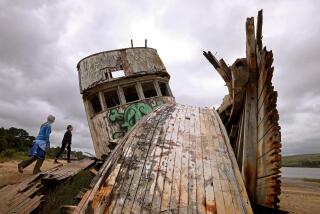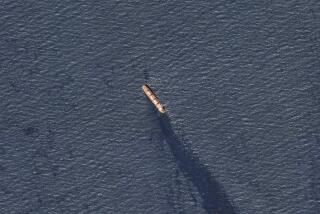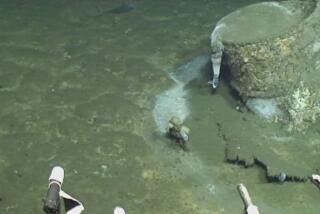Copper From Sunken Ship Poses Threat, Scientists Say
The ship Pac Baroness, which sank off Santa Barbara after a collision on Sept. 21, has broken up and its cargo of toxic copper ore has been scattered, thus posing a threat to marine life in the area, scientists said Thursday after getting their first detailed look at wreckage.
The affected area has been “very highly disrupted,” indicating that the Pac Baroness struck the ocean floor with a greater impact than had been expected, according to UC Santa Barbara researchers who observed the sunken vessel Wednesday night and Thursday with the aid of a video camera carried on a remotely operated miniature submarine.
“There was considerable twisting and buckling of the vessel. The hatches (to the cargo holds) are gone. And most of the ore is gone,” geologist Stan Margolis, who headed the expedition, said Thursday afternoon in a radio-telephone interview as the research vessel carrying the submarine prepared to head back to shore.
Since the accident, environmentalists have expressed the fear that toxic ore may have a severe effect because the wreck is located near major fishing areas that are rich in Dover sole and rock cod.
The ship’s bow is separated from the rest of the vessel, and its midsection is partially buried in sediment, Margolis said, adding that there is so much debris protruding from the ship’s midsection that they were not able to inspect it closely for fear of entangling the submarine.
“We’ll need a manned submersible to study that,” he said.
Debris from the Pac Baroness was spread over an area of about a third of a mile, Margolis added.
The 550-foot Pac Baroness was carrying 23,000 tons of finely powdered copper, iron and sulfur concentrates to Japan and had taken on a load of fuel in Long Beach before it collided with the 600-foot Atlantic Wing north of the Santa Barbara Channel.
The Atlantic Wing, carrying 3,451 Honda cars, continued its trip to Long Beach, but the Pac Baroness sank 11 hours later in 1,480 feet of water. There were no injuries in the accident.
An oil slick from the Pac Baroness threatened the coastline and a marine sanctuary for several days before dissipating in rough seas.
After two days of round-the-clock study at the wreck site, about 15 miles south of Point Conception, the UC Santa Barbara expedition has produced more than five hours of videotape and more than 300 photographs of the wreckage and the surrounding area, Margolis said.
The team also collected soil and water specimens from the immediate area and specimens of marine life. These will be analyzed at the university over the next few weeks so that scientists can get a better idea of the fate of the copper ore and its effects on ocean life, Margolis added.
He noted that they had observed “abundant” marine life in the area of the wreck, more than they had observed on a previous expedition in November, but they were not sure what that observation meant. On that visit, the team located and imaged the wreck with sonar, but they were not able to observe it visually because the submarine malfunctioned.
Margolis cautioned that the abundance of marine life does not mean the area is environmentally safe. Copper is a chronic poison whose effects may become apparent only over a long period of time.
The $90,000 expedition was federally sponsored.
More to Read
Sign up for Essential California
The most important California stories and recommendations in your inbox every morning.
You may occasionally receive promotional content from the Los Angeles Times.










